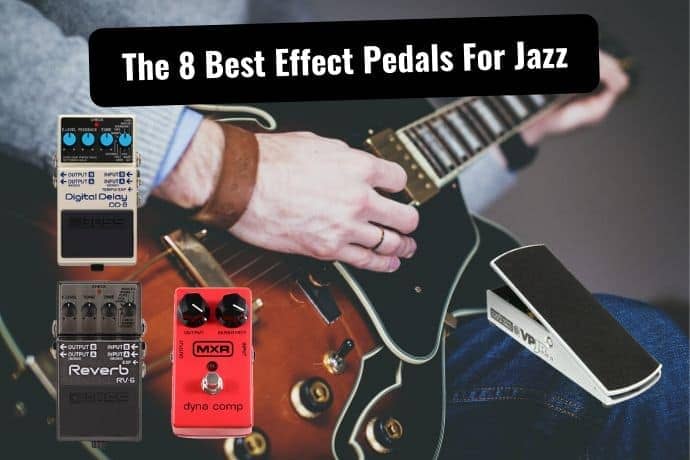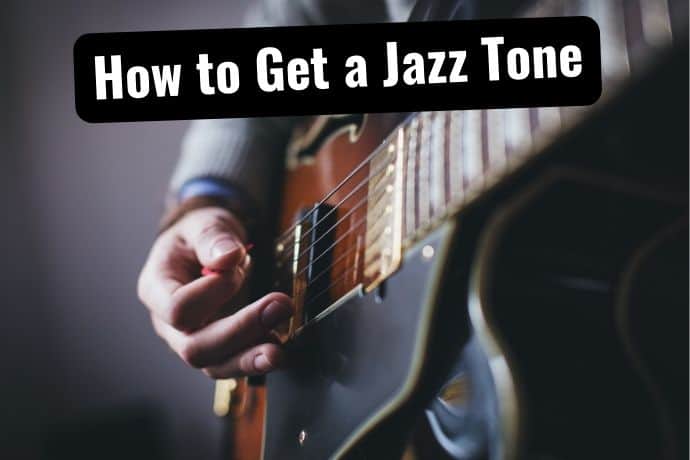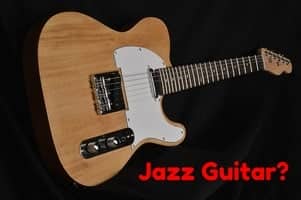
Do you want to know the usual guitar effects in a jazz player’s pedalboard?
In this article, I will offer you my selection of awesome guitar pedals ideal for any jazz player.
Whether it’s traditional, fusion, or anything else, you name it and this post has you covered! Let’s unwrap this post…
The best and most popular effect pedals for jazz guitar players are reverb, delay, chorus, compression, and an octave pedal. These effects help enhance a mellow clean tone by offering character and flavor, thereby helping your jazz tone stand out.
Before we begin…
It has to be noted, the sound of jazz guitar is classified as a playing style rather than a specific guitar tone.
The jazz tone is defined as a simple, clean, transparent, and mellow sound which means that this sound is easily attainable from pretty much every guitar amp out there.
However, the jazz players add flavor, personality, and variation to their sound. So how do they do this? Well, by simply engaging with guitar effects to enhance and modify their guitar tone sound.
Let’s dive right into my list with pedal number one…
1# – Compression
As discussed, the Jazz guitar tone is famed for its clean, transparent and warm tone.
Therefore, a compressor pedal is close to essential for a player looking to attain a crisp and defined clean sound. These players are mostly country, jazz, and funk guitarists among various other genres.
Why Compression Is Required for a Jazz Tone
- Increases note sustainability
- Provides added punch and volume
- Provides clean tones with additional dynamics and flair
- Tames loud wayward frequencies
- Boosts quieter frequencies
- Can be utilized as a subtle clean boost instead of a booster pedal
- Keeps the volume consistent
Compression functions by squashing high and low transience together which helps stabilize your sound keeping all your notes and chords at a consistent volume.
This compression of transience by lowering wayward frequencies provides a balanced sound, thus improving the guitar tone as a whole.
Compression works wonders for creating a dynamic, louder, and balanced clean tone which all jazz players want.
This pedal works exceptionally well for guitars with single-coil pickups installed. A guitar with humbuckers naturally compresses a tone whereas single-coil pickups have less of this ability.
2# – Reverb
Reverb is an essential guitar effect for any jazz player, it can give the illusion of space by providing a guitar tone with texture and ambiance.
Jazz players can either add a subtle touch of reverb, mimicking the ambiance of a small ballroom, or drench their tone in reverb, mimicking the wet sound of a large auditorium.
A lush spring reverb is a traditional choice for jazz players wanting a pristine texture and a touch of ambiance for their sound.
This effect is used in multiple genres but works exceptionally well for a clean jazz sound. It notably adds space and depth to a clean tone while also providing an emotional touch to your playing.
Jazz players in the past used to use analog reverb provided on amplifiers, notably the legendary Fender Twin Reverb, till digital reverb came along in a compact pedal providing more reverb types, dials, settings and ultimately more flexibility and control.
Reverb is a great addition to any jazz player’s effects board if your amps reverb is not cutting the mustard. Effect pedal reverb gives you more flexibility when it comes to tonal options.
In short, reverb can be used by Jazz Players for:
- Adding ambiance
- Mimicking the sound for small and large spaces
- Providing texture
- Enhancing a guitar tone with emotion
3# – Delay
Delay is one of the most versatile guitar effects a jazz player could own. From long echoing trails to short slapback delays, this pedal, combined with reverb, can provide jazz players with larger than life sounds.
In the modern age, jazz players are known to utilize delay effects more than ever before especially when in combination with other effects such as sustainer and reverb effect pedals.
Delay effects vary from small and compact stompbox pedals to larger and more advanced analog delay units.
Stompbox pedals are mostly digital delay effects with a handful amount of delay settings and preset customization which is enough for any minimal jazz player with limited pedalboard space.
In comparison, larger analog delay units such as the Line 6 DL4, can create, edit, and save custom patches, offering infinite amounts of delay options and flexibility.
Although these larger analog units are pricier, they are worth every penny for jazz players looking to have the ultimate delay experimental unit at their disposal.
In summary, Delay is used for:
- Long trailing nuances
- Short delays for slapback tones
- Giving the illusion of two guitar signals providing a thicker tone
- Utilizing as reverb
- Blending well with other time-based effects and modulation
- Adding ambiance and enhancing emotion in your playing
- Giving the illusion of space and a doubled guitar signal
4# – Chorus
Modulation effects are used to add a subtle texture to a clean tone giving the illusion of two separate guitar signals with a hint of spacey sounds.
Not only that, the chorus offers a lush and rich sound on top of a warm guitar sound, thus enhancing the vibey and smooth ambiance when it comes to jazz playing.
Jazz players have traditionally used chorus effects for decades with the purpose of adding a different dimension to their sound.
Coupled with reverb and other time-based effects, the chorus adds a new dimension that should not be overlooked for jazz guitar players.
Chorus sounds best for cleaner tones but doesn’t work well for distorted guitar signals.
It adds a nice icing on the cake when you dial in a good clean tone. Players either add a hint of the chorus for a mild amount of character or drench the signal in it to really make it stand out and catch the ear.
Chorus pedals usually come in compact stompbox pedals which allows players to easily change the rate, depth, effect level, and tone, depending on their taste.
Thus, Chorus can be used to:
- Give the illusion of two stereo guitar signals
- Adding depth and ambiance
- Providing lush and vibey clean tones
5# – Octave Pedal
Octave pedals are a great addition to any jazz player’s pedalboard. The most useful feature of the octave pedal is to recreate the sound of bass using a regular guitar.
You can do this by enraging an octave below your root guitar for the low-end sound of a bass guitar.
This, coupled with a looper pedal, allows guitarists to start a progression with a bass line once the bass line is recorded and plays its looped phrase.
You can get to create and start adding rhythmic chords or perhaps play silky jazzy leads, giving the illusion of a full ballroom band.
It allows you to get creative, play musical pieces and possibly stumble on a musical phrase that you want to keep for yourself.
Most jazz players do not get paid enough for gigs or do not have a bass player at their disposal.
Therefore, having an octave pedal allows players to mimic the sound of a bass guitar with their regular guitar. Again, it allows players to get creative to build upon a musical phrase and let their imagination run wild.
- Mimic the sound of a bass
- Add detuned chords and lead lines
- Provide bass notes with added low end for a similar sound to a real bass guitar
- Adds body to low strings of a regular guitar tone
6# – Overdrive/Distortion
Distortion and overdrive are obviously more popular with genres such as rock, blues, and metal.
However, some jazz guitar players sometimes require slightly overdriven sound for adding warmth and low-end to their sound. It helps enhance the sound of a lead tone adding more warmth and character.
Distortion is sometimes used to add a bit more grit and bite to enhance and assist their sound to stand out in a mix.
The best method is to always add a slight hint of overdrive and distortion, otherwise, you may mess up and add too much fizz and snarly to the tone, hence ruining the usual smooth and ambient sound of a clean and transparent jazz tone.
However, overdrive and distortion come in many forms and sounds.
The best option is to find the dirt sound you are looking for by testing a number of pedals and choosing the ones that retain the clarity without coloring the signal excessively.
With the many options of distortion and overdrive, you are spoilt for choice with the number of dirt pedals on the market.
To sum it up, Overdrive/Distortion can be used to/for:
- Adding more bite and aggression to the usual crystal clean jazz sound
- Providing warmth for a more detailed lead tone
7# – Sustainer pedal
Sustainer pedals are excellent to let your creativity and imagination run wild and a fantastic addition to a jazz pedalboard. They function the same in jazz pedalboards as they function in a piano.
This pedal essentially works by creating a small loop of your guitar signal (Not to be confused with a looper pedal) and can sustain a note or chord for however long you choose.
You can simply play a chord and engage the pedal and low and behold, it will hold this chord for as long as you keep your foot on the pedal.
This allows you to play lead lines over the top of the lopped recording giving the illusion of two guitar players with one signal.
You can get super creative by laying down a backdrop rhythm giving you the freedom to play jazzy lead lines.
It essentially helps craft potential jazz progressions and a base layer for adding lead and interesting phrases.
This pedal is a great addition to the pedalboard of any music player looking for crafting rhythm and lead progressions for songwriting.
Apart from that, it is awesome for live performances as it gives your guitar signal some flexibility and your audiences a spice.
In essence, the sustainer pedal can be used to:
- Hold audible notes for any length of time
- Create musical phrases
- Improve musicality and guitar songwriting
8# – Volume Pedal
A Volume pedal is excellent for control and provides a way of crafting interesting guitar techniques.
The first and simple way to adopt a volume pedal is to control the volume with your foot. You may be thinking ‘why not just use your volume knob on your guitar’?
I agree, this is a simple option. However, a volume pedal frees up the hands which means you can concentrate on your playing, which is what is most important at the end of the day.
Need a little boost in volume for a solo during a performance with your jazz band? Simply add a bit of volume using your pedal for more intricate control over your overall level.
The second way a volume pedal can be adopted is to use it as a way of creating lush swells.
Simply pluck a note or chord when the volume pedal is disengaged. Then, press down on the pedal to swell the volume back to smoothly bring in the strummed chord or note.
Combine this with delay and reverb and you can create ambient phrases by swelling your strummed chords for proving a lush, spacey and ambient jazz tones.
This is a great way of wowing your audiences by adding ambiance and character to your chords and songs.
In short, a volume pedal allows you to:
- Control your overall volume pedal using your foot
- Create lush swells
Thanks for Reading!
If you enjoyed this topic, you have to take a step further and read my ultimate guide, “How to get that Smooth Jazz Tone.”
It’s the ultimate jazz resource outlining guitars, amps, effects, strings, and playing style which you can use as your go-to guide for crafting a smooth and traditional jazz guitar tone.
Have you ever considered a Fender Telecaster as a suitable jazz guitar? To learn what I discovered, you must read my post,
“Why a Twangy Telecaster Can Play Jazz.” Learn why the country, funk, and rock legend is a surprisingly popular guitar for jazz players.
Learn why this popular country and rock guitar is actually a great guitar for jazz.


